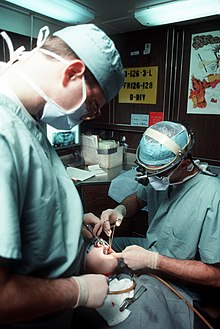This article contains too many pictures for its overall length. |
 A dentist treats a patient with the help of a dental assistant. | |
| Occupation | |
|---|---|
| Names | |
Occupation type | Profession |
Activity sectors | Health care, Anatomy, Physiology, Pathology, Medicine, Pharmacology, Surgery |
| Description | |
| Competencies |
|
Education required | Dental Degree |
Fields of employment |
|
Related jobs | |
| ICD-9-CM | 23-24 |
|---|---|
| MeSH | D003813 |

Dentistry, also known as dental medicine and oral medicine, is the branch of medicine focused on the teeth, gums, and mouth. It consists of the study, diagnosis, prevention, management, and treatment of diseases, disorders, and conditions of the mouth, most commonly focused on dentition (the development and arrangement of teeth) as well as the oral mucosa.[2] Dentistry may also encompass other aspects of the craniofacial complex including the temporomandibular joint. The practitioner is called a dentist.
The history of dentistry is almost as ancient as the history of humanity and civilization, with the earliest evidence dating from 7000 BC to 5500 BC.[3] Dentistry is thought to have been the first specialization in medicine which has gone on to develop its own accredited degree with its own specializations.[4] Dentistry is often also understood to subsume the now largely defunct medical specialty of stomatology (the study of the mouth and its disorders and diseases) for which reason the two terms are used interchangeably in certain regions. However, some specialties such as oral and maxillofacial surgery (facial reconstruction) may require both medical and dental degrees to accomplish. In European history, dentistry is considered to have stemmed from the trade of barber surgeons.[5]
Dental treatments are carried out by a dental team, which often consists of a dentist and dental auxiliaries (such as dental assistants, dental hygienists, dental technicians, and dental therapists). Most dentists either work in private practices (primary care), dental hospitals, or (secondary care) institutions (prisons, armed forces bases, etc.).
The modern movement of evidence-based dentistry calls for the use of high-quality scientific research and evidence to guide decision-making such as in manual tooth conservation, use of fluoride water treatment and fluoride toothpaste, dealing with oral diseases such as tooth decay and periodontitis, as well as systematic diseases such as osteoporosis, diabetes, celiac disease, cancer, and HIV/AIDS which could also affect the oral cavity. Other practices relevant to evidence-based dentistry include radiology of the mouth to inspect teeth deformity or oral malaises, haematology (study of blood) to avoid bleeding complications during dental surgery, cardiology (due to various severe complications arising from dental surgery with patients with heart disease), etc.
- ^ Neil Costley; Jo Fawcett (November 2010). General Dental Council Patient and Public Attitudes to Standards for Dental Professionals, Ethical Guidance and Use of the Term Doctor (PDF) (Report). General Dental Council/George Street Research. Archived from the original (PDF) on 4 March 2016. Retrieved 11 January 2017.
- ^ "Glossary of Dental Clinical and Administrative Terms". American Dental Association. Archived from the original on 6 March 2016. Retrieved 1 February 2014.
- ^ "Stone age man used dentist drill". BBC News. 6 April 2006. Retrieved 24 May 2010.
- ^ Suddick, RP; Harris, NO (1990). "Historical perspectives of oral biology: a series". Critical Reviews in Oral Biology and Medicine. 1 (2): 135–51. doi:10.1177/10454411900010020301. PMID 2129621.
- ^ "When barbers were surgeons and surgeons were barbers". Radio National. 15 April 2015. Retrieved 10 September 2021.
Cite error: There are <ref group=nb> tags on this page, but the references will not show without a {{reflist|group=nb}} template (see the help page).